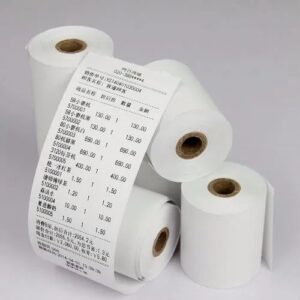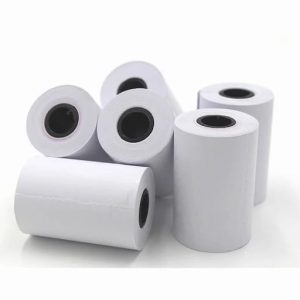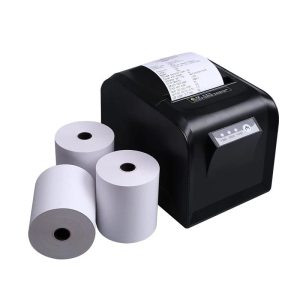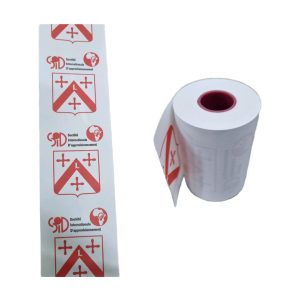What Is the Difference Between Thermal Paper and Normal Paper?

Understanding What Is the Difference Between Thermal Paper and Normal Paper?
You probably use receipts, labels, or tickets every day; however, thermal paper and normal paper differ significantly, especially in how they interact with printers. Therefore, understanding these differences helps you choose the best type for your business or personal needs.
In this guide, we will explain how each type works, outline their advantages, and clarify why selecting the correct paper affects efficiency, cost, and print quality.
How Thermal Rolls Work — What Is the Difference Between Thermal Paper and Normal Paper?
How Thermal Printing Works

Thermal rolls have a heat-sensitive coating that changes color when exposed to a printer head. Consequently, this method is cleaner, faster, and reduces maintenance costs compared to normal paper. Additionally, thermal printing requires no ribbons or cartridges, which further minimizes downtime.
You can read more on Wikipedia.
Normal Paper Printing — What Is the Difference Between Thermal Paper and Normal Paper?

In contrast, normal paper requires ink or toner for visible prints. Therefore, printing takes longer, and frequent replacements increase operational costs. Consequently, businesses that rely on speed may prefer thermal rolls over normal papers.
Types of Thermal Rolls – What Is the Difference Between Thermal Paper and Normal Paper?

Understanding these differences helps you select the right paper:
Till Roll
First, this roll is widely used in retail and restaurant POS systems.
Credit Card Rolls
Next, these rolls are designed for card terminals and speed points.
Thermal Paper Collection
Finally, this collection offers various sizes for all business needs.
Each type demonstrates how thermal rolls adapt to specific applications, whereas normal papers is less specialized.
Industrial Applications
Retail and Hospitality
For instance, thermal rolls print receipts, labels, and order tickets quickly, remaining smudge-resistant and legible. As a result, businesses improve efficiency and customer satisfaction.
Office and Administrative Use
Meanwhile, normal paper is mainly used for office documents, invoices, and reports. Although durable, it prints slower and is less suitable for fast-paced environments like retail or logistics.
Cost and Maintenance Comparison
Cost Efficiency
Thermal rolls eliminate ink expenses, thereby reducing overall printing costs. In contrast, normal paper requires cartridges, which increase long-term operational costs.
Printer Maintenance
Moreover, thermal printers need fewer repairs, whereas normal papers printers require regular cleaning and cartridge replacements. Consequently, maintenance becomes a more significant factor for businesses using normal papers.
Thermal Rolls vs Normal Paper — Side-by-Side Comparison
| Feature | Thermal Rolls | Normal Paper |
|---|---|---|
| Printing Method | Heat-sensitive coating reacts instantly | Ink or toner applied via printer |
| Print Speed | Very fast; ideal for high-volume transactions | Slower due to ink/toner transfer |
| Smudge Resistance | High; prints remain clean | Moderate; ink may smear |
| Maintenance | Low; no ink needed | High; requires cartridge replacements |
| Cost Over Time | Lower; no consumables | Higher; ink/toner costs accumulate |
| Durability | Moderate; sensitive to heat, sunlight, oils | Higher; ink may last longer |
| Environmental Impact | Lower; fewer consumables | Higher; ink cartridges and ribbons produce waste |
| Applications | POS receipts, labels, tickets, banking slips | Office printing, reports, forms |
Example:
For example, in a South African retail store, thermal receipts printed during a busy month remained smudge-free, whereas normal paper receipts showed minor fading. Therefore, this demonstrates the practical advantages of thermal rolls.
Quality, Durability, and Environmental Benefits
Print Durability
Thermal rolls produce sharp, smudge-free images. However, they should be stored away from heat, sunlight, and oils. Meanwhile, normal paper relies on ink quality, which may fade over time.
Environmental Considerations
Additionally, thermal rolls use fewer consumables, while ink-based printing generates more waste. Therefore, businesses aiming for sustainability may prefer thermal rolls. BPA-free options are recommended for safety.
For durability tips, visit our Thermal Papers Collection.
Storage Recommendations – What Is the Difference Between Thermal Paper and Normal Paper?
Proper storage also affects thermal rolls. For instance, they should be kept in a cool, dry place away from sunlight, oils, and adhesives. In contrast, normal paper can yellow or warp in humid conditions.
For expert guidance, visit our Contact Page.
Summary
In conclusion, thermal papers and normal papers differ in printing method, speed, cost, and durability. Thermal rolls print via heat, require no ink, and are faster. Normal paper relies on ink or toner but is better for long-term storage.
Therefore, choosing the right type ensures efficiency, cost savings, and consistent printing results.
FAQs
- Which lasts longer?
Normal paper lasts longer; however, thermal rolls print faster and cleaner. - Are thermal rolls safe?
Yes, particularly when using BPA-free options. - Can thermal rolls be recycled?
Yes, many modern types are recyclable. - Where can I buy them?
Explore Country Paper’s Thermal Papers Collection or Till Roll today.



